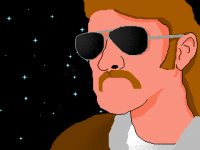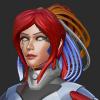Hi, programmer here
I made a 3d model in blender an now I need to texture it. I know this can be done in blender and I have been doing it. The problem is that my 3d engine only allows 1 texture per object and I have been assigning each face to a certain texture. I don't entirely understand how textures work in blender, so I was wondering the procedure for starting with a textureless 3d model and creating one texture for that model and mapping it properly?
The best way to texture a 3d model?
Cool, I just started using blender this weekend, but I think this video has a decent walkthrough (might be in part 2): http://cgcookie.com/blender/2011/06/08/creating-a-lowpoly-concrete-barrier-part-01/.
I'm interested in what some of the 3D veterans have to say, too. Followed.
I'm interested in what some of the 3D veterans have to say, too. Followed.
There are many, many ways of texturing an object, and which you choose depends greatly on your personal skills as well as the use to which the model will be used and the over-all texture budget you have to work with. Here is a very brief and wholly insufficient list of a few ways you can texture your object:
1) Procedural
Procedural textures can be useful in certain circumstances. Procedurals attempt to mimic the surface or volume characteristics of an object without resorting to explicit UV mapping. If the model is intended for use in a game, you might be limited by shader instruction count and/or complexity, so typically you will avoid procedurals except for things such as water and so forth. If the model is intended for an in-Blender render, though, then you can get a lot of mileage out of procedural, node-based materials and never touch a UV map.
2) Hand-paint directly onto object, or via external paint application such as Gimp
Blender allows you to do texture painting directly on the model. You set up your UV mapping, ensuring that each face has its own unique space in the UV map with no overlap with other faces. Create a texture and go into Texture Paint mode. Paint away, save your texture as an image.
3) Painted and baked from high-poly
A process that is frequently used, especially with characters, is to model your object in very high detail and paint it, then bake out various textures including normal map or displacement map, ambient occlusion, diffuse, specular, etc... to textures that are applied via UV texturing to your lower polygon model. Blender offers this functionality using the Bake menu tab under Render settings (Blender Internal Render engine only; Cycles doesn't offer baking yet).
A good process for this technique is to start with the low-poly object you intend to use in the game. Add a multi-resolution modifier to it and crack the detail up a bit, then sculpt in some details. (If you set up your UV mappings on the low-poly, the multi-res modifier will also subdivide those UV mappings) You can use texture painting to paint directly on the model in blender, and you can even paint to multiple textures in order to do a diffuse map and a specular map. Then you can bake all of these to images to load into the game.
4) Modular UV mapping using seamless, pre-made textures.
If you are on a very limited texture budget and can not afford to have a unique texture for every object, you can create a small set of textures that are seamlessly tiling, then manipulate the UVs of the faces of your object to figuratively "snip" pieces of these textures out in creative ways. Multiple objects can share textures this way, greatly saving texture budget.
One of the more instructive polycount threads I have read recently is this one: http://www.polycount.com/forum/showthread.php?t=87797
Not only is it instructive in technique (pay attention to the posts in the thread that discuss the seamless UV mapping trick in 4) but it is also interesting to see one particular artist's progress as she learns multiple techniques and in the end produces a very striking and beautiful scene using all sorts of nifty tricks.
Polycount in general is a highly useful forum to browse if you are starting out, so you might spend some time over there learning things that will blow your mind.
Good luck.
1) Procedural
Procedural textures can be useful in certain circumstances. Procedurals attempt to mimic the surface or volume characteristics of an object without resorting to explicit UV mapping. If the model is intended for use in a game, you might be limited by shader instruction count and/or complexity, so typically you will avoid procedurals except for things such as water and so forth. If the model is intended for an in-Blender render, though, then you can get a lot of mileage out of procedural, node-based materials and never touch a UV map.
2) Hand-paint directly onto object, or via external paint application such as Gimp
Blender allows you to do texture painting directly on the model. You set up your UV mapping, ensuring that each face has its own unique space in the UV map with no overlap with other faces. Create a texture and go into Texture Paint mode. Paint away, save your texture as an image.
3) Painted and baked from high-poly
A process that is frequently used, especially with characters, is to model your object in very high detail and paint it, then bake out various textures including normal map or displacement map, ambient occlusion, diffuse, specular, etc... to textures that are applied via UV texturing to your lower polygon model. Blender offers this functionality using the Bake menu tab under Render settings (Blender Internal Render engine only; Cycles doesn't offer baking yet).
A good process for this technique is to start with the low-poly object you intend to use in the game. Add a multi-resolution modifier to it and crack the detail up a bit, then sculpt in some details. (If you set up your UV mappings on the low-poly, the multi-res modifier will also subdivide those UV mappings) You can use texture painting to paint directly on the model in blender, and you can even paint to multiple textures in order to do a diffuse map and a specular map. Then you can bake all of these to images to load into the game.
4) Modular UV mapping using seamless, pre-made textures.
If you are on a very limited texture budget and can not afford to have a unique texture for every object, you can create a small set of textures that are seamlessly tiling, then manipulate the UVs of the faces of your object to figuratively "snip" pieces of these textures out in creative ways. Multiple objects can share textures this way, greatly saving texture budget.
One of the more instructive polycount threads I have read recently is this one: http://www.polycount.com/forum/showthread.php?t=87797
Not only is it instructive in technique (pay attention to the posts in the thread that discuss the seamless UV mapping trick in 4) but it is also interesting to see one particular artist's progress as she learns multiple techniques and in the end produces a very striking and beautiful scene using all sorts of nifty tricks.
Polycount in general is a highly useful forum to browse if you are starting out, so you might spend some time over there learning things that will blow your mind.
Good luck.
For performance, keep the texture as small as possible, have as few files of various kinds in the model folder, such as materials, textures, or other. The ideal is to have no more than one material, one texture, and one image file in the model folder, though sometimes needs cause this to rise. Don't make the common newbie mistake of having a lot of image files, such as one image file per part.
Any faces which are exact duplicates in the UV map undisturbed in exactly the same location also slightly increases performance if only one texture is used. When several textures are used across similar parts, try to find ways of using more parts per texture to help game performance. Keep the number of separate parts, files, and textures to a minimum. Polygon count should be as small as possible. A smaller model is also less demanding than a larger one which is equal in every other way. Rendering hurts performance more than rasterization, so try to avoid a rendered model in a game if possible and use conventional textured models when you can, though shading or smoothing can be used.
Clinton
Any faces which are exact duplicates in the UV map undisturbed in exactly the same location also slightly increases performance if only one texture is used. When several textures are used across similar parts, try to find ways of using more parts per texture to help game performance. Keep the number of separate parts, files, and textures to a minimum. Polygon count should be as small as possible. A smaller model is also less demanding than a larger one which is equal in every other way. Rendering hurts performance more than rasterization, so try to avoid a rendered model in a game if possible and use conventional textured models when you can, though shading or smoothing can be used.
Clinton
If your engine allows only 1 texture per object, then what you will need to do is to assign same texture to every piece/mesh of that object. Then each mesh use different part of the texture map. Ta da.
Examples below.
In this texture map, there's only 1 mesh, the head.

In this one, however, is more than just the head. It's the whole body. This is what you will want to do.

Examples below.
In this texture map, there's only 1 mesh, the head.

In this one, however, is more than just the head. It's the whole body. This is what you will want to do.

This topic is closed to new replies.
Advertisement
Popular Topics
Advertisement








